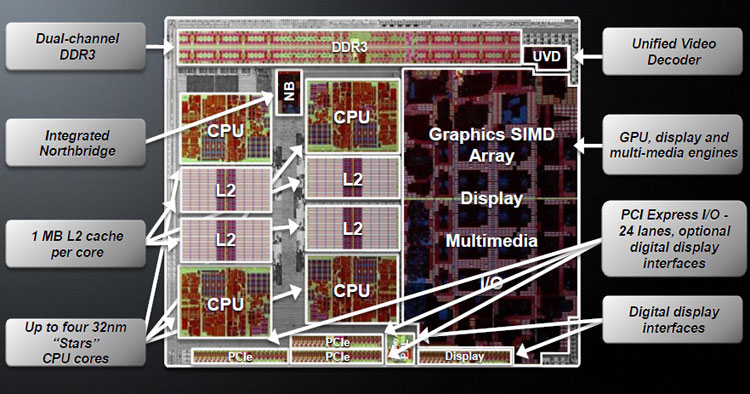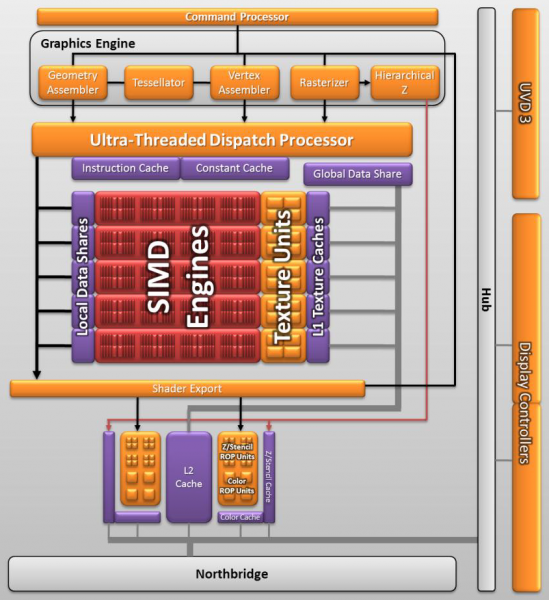The APU - Llano - AMD A6-3650
APU
As you guys have learned by now Llano is a processor series with integrated graphics (in the processor die), an idea much like Intel did with Sandy Bridge.
AMD calls this an APU, an Accelerated Processing Unit. Back in 2005 when AMD bought ATI rumors immediately popped up about the technology you will learn about today.
Make no mistake though, in the introduction we already mentioned that AMD already launched APUs like the E350 (Zacate and Ontario chips), these however can be seen as 'Atom' like processors for netbooks and entry level notebooks. The Llano series is intended to address the entry-level to mid-range segment of both the notebook, but also desktop market. And for that Llano needs to be a heck of a lot more powerful then Zacate, not just in processing power, but also GPU power as that is AMD's strong point opposed to Intel.
The processor reviewed today for example is targeted against Intel's Sandy Bridge Core i5 2300 and 2400 processors. Now processor power wise things will be easy, Intel has the upper hand, but the GPU architecture in Llano is just so much more advanced allowing you to do much more with less components in your PC, especially in the multi-media segment Llano APUs are going to dominate as that overall experience is much more powerful.
Combine that with a much more advanced motherboard chipset, A75, and you'll notice that AMD has a lot more to bring to the table.
Llano
So with Llano APUs AMD is going to target the PC entry-level to mid-range segment, ie. mainstream. Two derivatives come from Llano - there's Sabine for the notebook platform, and then there's Lynx, for the desktop processor market -- thus the PC. Lynx processors will slowly start to replace processors like the Athlon II, Phenom II and Turion series -- that, we think, might already happen before the end of this year.
For the more real mainstream to enthusiast desktop PC platform AMD will release Bulldozer (FX) processors, you can pair these with a dedicated graphics card for the more hardcore experience.
The AMD A6-3650 processor
We told you about the three series Llano APUs (A4/A6/A8), today the first processor that we test is the AMD A6-3650 processor, AMD obviously releases and submits their fastest offering for review first.
To get a better idea behind the architecture of this APU we'll need to dissect it for you as the APU really is an accumulation of parts that you guys all know. Llano Lynx processors are made on a 32nm node with a chip die-size of 228 mm² (a petit fraction bit bigger then Intel's Sandy Bridge at 214 mm²), that's very comparable to SB, both APU's also have roughly 1 Billion transistors.
Lynx has three primary elements merged into the APU, the Northbridge, the CPU and the GPU. Intel places more focus on raw CPU performance, AMD places more focus on the multi-media experience, thus the GPU.
There's a heck of a lot more to be found inside the APU though, a DDR3 memory controller, Unified Video Decoder core logic, that Northbridge, a PCI Express interface (24 lanes) and of course a DDI interface to output to digital monitors.
If we focus a little on the processor then sure, there's nothing new under the sun there. AMD says that the quad 32nm cores are based off their Stars design. And there's nothing easier than that to explain by way of an example. It's very simple... the Stars design thus architecture was used for Athlon II and Phenom II CPU cores as well, and unfortunately it is not based on new architecture like Bulldozer (FX) processors are going to offer.
That means that each of the four CPU cores will have 64KB instruction + 64KB data L1 cache per CPU core. Then there's 1MB of L2 cache per CPU core and for Llano... there's no shared L3 cache, which to this date is a decision I do not understand as that is going to hurt overall processor performance. The processor cores have been tweaked though the average instruction per clock-cycle has improved by a good 6% but yeah, if you look at the processor's cores in the most simplistic way it is similar to the Athlon II X4 cores which also lack that L3 cache.
One vast improvement for Llano is AMD Turbo Core, and the technology has been enhanced. The Turbo mode can clock the processor cores up and down real fast when the power usage and temperature allow for it. The A6-3650 APU tested today however does not come with Turbo Core. More on that later.

The GPU: 320 versus 400 Shader Units
Though we feel that on the processor side AMD might have forfeited a little bit too much, they compensate with a very powerful graphics engine harbored inside that CPU. Let's realize one thing here, integrated GPUs (whether that is in the chipset or CPU) have always sucked in terms of performance. Now we are not claiming that integrated solutions (especially in a CPU) will ever reach the level of a dedicated graphics card, but we do have to acknowledge that what AMD placed into Llano is very impressive.
Llano will become a special "processor" due to the fact a fully functional DirectX 11 GPU is injected into the die. The codename for the IGP part is Sumo, and sure... you will recognize the architecture here as well as it is obviously based off Radeon architecture, the closest GPU we can find that relates to Sumo is the Radeon HD 5500 and 5600, Redwood.

Now, placing a GPU on a graphics card is very different from injecting it into a processor and as such there definitely are quite a few design changes. The most primary being graphics memory. The GPU addresses the very same memory controller as the CPU does, and that means a shared pool of your DDR3 memory will be used for the GPU to use as a framebuffer. Actually, 512MB of your DDR3 memory is utilized for the graphics subsystem. The memory controller was optimized to support 1866 MHz DDR3 memory just to get the GPU more memory bandwith.
Bare in mind the 3800 series APUs have 400 shader processors active whereas the 3600 series have 320 SPs activated.
To complement the multi-media experience, the UVD engine is harbored in Llano as well, it is actually UVD3, the latest revision used on the Radeon 6000 series and that means serious support for Full HD content playback with even 3D Blu-Ray capability, UVD3 is a very powerful video processor.
The IGP will provide support for two monitors and all common connectors will be supported including HDMI, DVI, DisplayPort and DSUB (VGA).

For the real Gurus, the GPU is 99% based on the Radeon 5500 series architecture with the very same fixed pipeline setup.
The A8 series APUs will have 5 SIMD engines with 20 Texture units tied to them. The GPU has 8 color ROPs. The GPU itself will run at a clock frequency of 600 MHz which will deliver roughly half a GFLOP of computational performance.
The A6 series APUs will have 4 SIMD engines with 16 Texture units tied to them. The GPU has 8 color ROPs. The GPU itself will run at a clock frequency of 444 MHz which will deliver roughly 284 MFLOP of computational performance.
